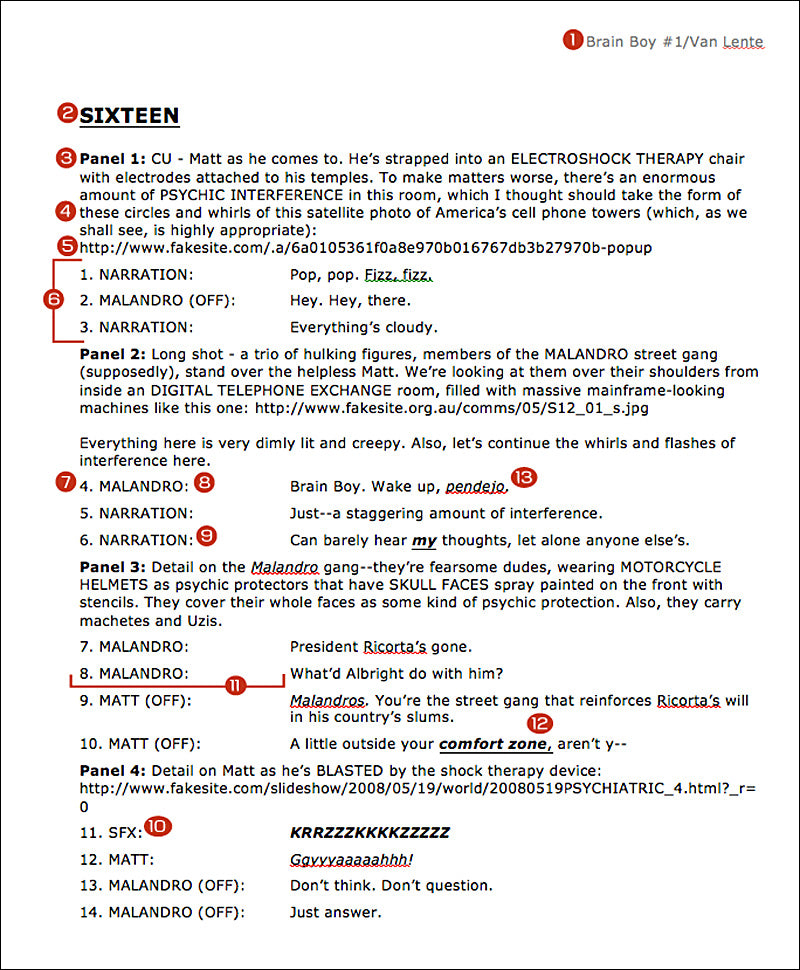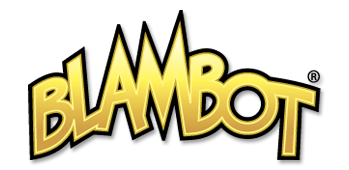Comic Script Basics
Be prepared to see a lot of differently formatted scripts from writers if you want to letter comics. Above all else, simplicity and specificity are what make for the best form. Often the editor and letterer have to comb through a malformed script and tidy it up before the next step in the creative process. Common mistakes are probably the result of not seeing other writers' form; a lot of comics freelancers tend to work in a vacuum. Comics scripts share their roots with playwriting/screenwriting, but have some specific differences, as you'll see.
When I started thinking about putting together an article, the work of Fred Van Lente sprung to mind as probably the best example of script writing that I currently work with. Fred's good habits and attention to detail make working with one of his scripts a real pleasure, and a blast to read! I was thrilled when Fred (and Dark Horse) gave me permission to use the following page from BRAIN BOY #1.
Below, you'll see a page of Fred's script, written in MS Word, (the industry standard) that has numbered bullets corresponding to a breakdown, below.

1) A page header with the book title, number and writer's name.
2) Each new script page should begin on a new document page. And you can't miss the page number when it's big and bold. Often, I have to skim through a script to look for a note or direction. Big page numbers help tremendously.
3) Panel numbers almost as bold and clear as the page number.
4) Panel descriptions for the most part don't have to be that lengthy unless it's really necessary. The actions of characters should be here, (not in the lettering area; see #6) set direction, and notes to the other members of the creative team if necessary.
5) Also, the digital age has given us the greatest source of reference that comic creators have ever had access to. Links to reference photos should also be included in the panel description.
6) Under each panel description is the lettering area. Everything that needs to be lettered goes here.
7) Each item in the lettering area should be numbered. If the editor is doing lettering placements, these numbers correspond to the placements sent to the letterer.
8) The call-out of each lettering item and any descriptors like these:
CHARACTER (OFF), meaning the character is speaking from off-panel.
CHARACTER (WHISPER), self-explanatory.
CHARACTER (BURST), meaning the dialogue is shouted and should be in a burst balloon.
CHARACTER (WEAK), character's dialogue should be diminished.
CHARACTER (SINGING), self-explanatory. Usually accompanied by music notes.
9) Like dialogue, captions have their own descriptors:
NARRATION or CAPTION (CHARACTER), self-explanatory. The inner thoughts of a character.
CAPTION (TIME/PLACE), such as, "New York, 2013."
CAPTION (VOICE OVER), meaning the character is speaking, but is not in the location shown in the current panel.
10) SFX, self-explanatory, "sound effect".
11) Dialogue should be indented, NOT tabbed over. If you use tabs, the letterer has to run find/replace searches on the document to delete them all before lettering. (To use indents in MS Word, go: Format / Paragraph / Indents & Spacing.) Dialogue should also be written in plain sentence case, not CAPS.
12) Dialogue that should be bold in the comic, should be bold and/or underlined in the script. If you use caps for bold dialogue, the letterer will have to convert it to sentence case before lettering.
13) Non-English dialogue should be italic. Whole blocks of dialogue that are translated into English, should begin with a < and end with a >, and are usually accompanied by a caption explaining what language is being spoken.
As you can see, simplicity and common sense rule the day. As soon as a script is turned in, it's the touchstone for the rest of the entire creative team. We want to be able to absorb the story you're telling with the least amount of clutter or confusion. It's makes our jobs that much easier.
If you would like a copy of Fred Van Lente's superb MS Word comic script templates for free, visit this page of his website!
Now, let's take a look at how that scripted page turned out in the finished comic...

BRAIN BOY ™ & © Dark Horse Comics, Inc.

